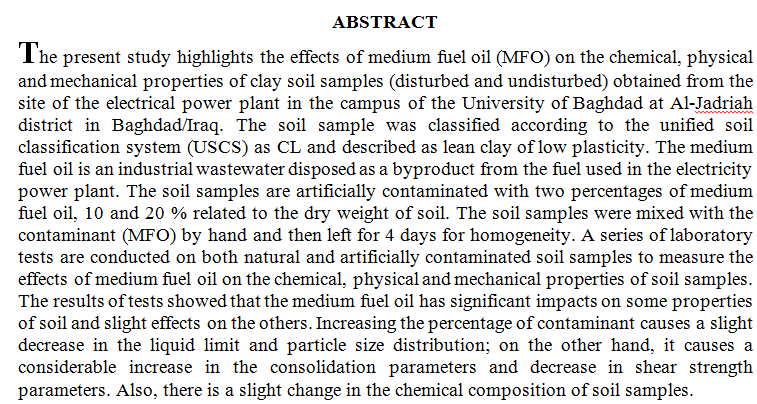
 (13)
(13)
 (1)
(1)
 (1)
(1)
In this paper, we used two monomers, 3,3',4,4'-benzophenone tetracarboxylic dianhydride (BTDA) and m,m'-diaminobenzophenone (m, m’-DABP), to produce polyamide acid and then converted it to polyimide (PI). The effects of phosphoric acid (H3PO4) molarity (1, 2, and 3 M) on the structural, thermal, mechanical, and electrical characteristics of the polyimides/polyaniline (PI/PANI) nanocomposites were studied. Two sharp reflection peaks were developed by the addition of PANI to PI. When 3 M H3PO4 is added, the crystalline sharp peak loses some of its intensity. The complex formation of PI/PANI-H3PO4 was confi
... Show More (18)
(18)
 (16)
(16)
A polycrystalline PbxS1-x alloys with various Pb content ( 0.54 and 0.55) has been prepared successfully. The structure and composition of alloys are determined by X-ray diffraction (XRD), atomic absorption spectroscopy (AAS) and X-ray fluorescence (XRF) respectively. The X-ray diffraction results shows that the structure is polycrystalline with cubic structure, and there are strong peaks at the direction (200) and (111), the grain size varies between 20 and 82 nm. From AAS and XRF result, the concentrations of Pb content for these alloys were determined. The results show high accuracy and very close to the theoretical values. A photoconductive detector as a bulk has been fabricated by taking pieces of prepared alloys and polished chemic
... Show MoreReactive Powder Concrete (RPC) is one of the most advanced recent high compressive strength concrete. This work explored the effects of using glass waste as a fractional replacement for fine aggregate in reactive powder concrete at levels of 0%, 25%, 50%, and 100%. Linear and mass attenuation coefficients have been calculated as a function of the sample's thickness and bremsstrahlung energy. These coefficients were obtained using energy selective scintillation response to bremsstrahlung having an energy ranging from (0.1-1.1) MeV. In addition, the half-value thickness of the samples prepared has been investigated. It was found that there is a reversal association between the attenuation coefficient and the energy of the bremsstrahlu
... Show More (2)
(2)
 (1)
(1)
 (57)
(57)
 (53)
(53)
Noor Oil Field is one of Iraqi oil fields located in Missan province / Amarah city. This field is not subjected to licensing rounds, but depends on the national effort of Missan Oil Company. The first two wells in the field were drilled in seventies and were not opened to production until 2009. The aim of this study is to study the possibility of using the method of gas lift to increase the productivity of this field . PROSPER software was used to design the continuous gas lift by using maximum production rate in the design.
The design was made after comparing the measured pressure with the calculated pressure, this comparison show that the method of Beggs-Brill and Petroleum Exper
... Show MoreIt is well known that monotherapy does not provide therapeutic response in all hypertensive. Somepatients show an excellent response, while in others there is a poor response. Combinationantihypertensive therapy is administered when blood pressure is inadequately controlled bymonotherapy to achieve a balanced and additive antihypertensive effect with minimum adverse effects.Both angiotensin converting enzyme (ACE) inhibitors and dihydropyridine type of calcium antagonistsare well established and widely used in monotherapy. An understanding of differences in themechanism of action of these agents allows a logical approach for the use of these agents as acombination therapy. This study was designed to evaluate the possible beneficial
... Show MoreIn the present work, heterojunction diode detectors will be prepared using germanium wafers as a substrate material and 200 nm tin sulfide thickness will be evaporated by using thermal evaporation method as thin film on the substrate. Nd:YAG laser (λ=532 nm) with different energy densities (5.66 J/cm2 and 11.32 J/cm2) is used to diffuse the SnS inside the surface of the germanium samples with 10 laser shots in different environments (vacuum and distilled water). I-V characteristics in the dark illumination, C-V characteristics, transmission measurements, spectral responsivity and quantum efficiency were investigated at 300K. The C-V measurements have shown that the heterojunction were of abrupt type and the maximum value of build-in pot
... Show MoreThe present study aimed to evaluate the effect of lead exposure on hemopoetic system (through the index delta-Aminolevulinic acid dehydratase ?-ALAD activity & hemoglobin concentration (Hb) ) and on iron status (levels of iron Fe, Ferritin Fr, Total iron binding capacity TIBC, percentage of transferine saturation TF%) in 44 Iraqi worker at lead batteries factory. Workers divided into two groups: smokers(n=21) mean aged (37.33±4.82 year)and non smokers(n=23) mean aged(40.78±7.89 year) and 45 healthy subjects mean aged (33.97±5.08)as control group . Activity of ?-ALAD ratio shows significant decrease (p ? 0.05) ,while Hb and hematocrit Hct were non significant (p ? 0.05) in smoker workers more than non smoker as compared to control . The r
... Show More